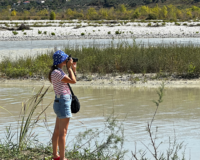By Prof. Aleko Miho
Respect for the different opinion of the socialist deputy in the Albanian Parliament a week ago, at the same time chairman of the Economy Committee, Mr. Braces! “The government has lost its political will, this is great greed”, he said! I am convinced that among the Parliamentarians and in other governing institutions there are others who think like Mr. Braces! This is hope for the country and for its future. On this occasion, I want to reiterate our opinion as a very repeated scientific academic world, and specifically:
We are not against the construction of HPPs categorically! But during the period 2005-2017, permits were given to build more than 500 HPPs, small and large, spread all over Albania. All mountain streams have turned into a construction site!

Only during the period February 2016 – May 2017 that I am aware of, more than 55 HPPs were examined in KTA! So in total in Albania it falls to about 18 HPP/1000 km2, the highest in the entire region. This is an extremely heavy environmental burden, if we take into account their synergistic or cumulative impact, which makes this activity even more worrying. Why is this a heavy environmental burden? Because the river ecosystems are disturbed during the construction, but also during the years of work, from new roads, dams, tunnels, canals, explosives, transmission lines, etc.
Some of the consequences are: slope erosion (coastal slopes, fragile slopes above, etc.), up to and including coastal erosion near river deltas; biodiversity depletion for habitats and their species (both aquatic and terrestrial); changes in bio-corridors (for invertebrates, fish and other aquatic vertebrates); water pollution with sediments and other pollutants (heavy metals, pesticides, bacteria) that are washed from the bare slopes and dried into the waters; up to the micro-climatic aggravations of the river ecosystem (in evapo-transpiration-humidity, air and water temperature, etc.).
It is worth affirming that the environmental expertise and professionalism of the entire decision-making structure for each construction project leaves much to be desired! Often very cursory, too hasty, without sufficient data, why not clientelistic or corrupt! Even the value of ecological flow in HEC does not seem to be very clear in our acts; perhaps it was defined not very professionally (Q350) for our country, both mountainous and Mediterranean.
Moreover, for HPPs in operation, I think that even the necessary structures that control the implementation of the water use permit and the ecological flow in particular are not strong and sufficient. Undoubtedly, all of these are not only a heavy environmental burden, but also a burden on the sustainable development of the country; it is enough to mention here that all of them, separately or together, reduce the quality of waters, the value of their use, and even affect human health itself.
Undoubtedly, this serious intervention in nature reduces even the tourist values of each area, which is one of our strong points of Albanian nature, often bent by politics as a hope for the development of the country, as a hope to get out of the backwardness inherited from the centuries!
But what raises our concern as an academic world and as a civil society is that a part of HPPs, but also other constructions (such as large touristic complexes) still continue to be provided within protected areas, or in ecological interaction with them . Here I mention the construction of HPPs within or ecologically close to Valbona Valley KP, Shebenik-Jabllanica KP, Hotovë-Dangëllia KP, Lura KP, interfering with our elite natural monuments, such as Osum Canyons, of Seta, Bênca, Lengarica, Ģaja, etc.
This cannot be considered friendly to nature, and cannot be sustainable in principle, if we take into account the consequences mentioned above. Why do we proclaim and defend PAs then? From what harmful activities, if not from human constructions?
Such construction projects (HECs, tourist resorts, etc.) are contrary to preserving the integrity of PAs. I clarify for the reader that natural and biological integrity relates to the overall pristine, intact, unbroken state of an ecosystem. Protected areas are distinguished for natural habitats with high integrity values, which means high biological diversity (plant and animal, aquatic and terrestrial), equal housing and coexistence ability, undisturbed and adapted for plants and animals. For this, the protected areas are kept away from human use for the purposes of immediate profit, whether for the use of wood, aromatic-medicinal plants, grazing, and moreover also from the construction of HPPs or mass tourism (concreting); they are strictly protected from fires, and from many intrusions that conflict with their integrity.
Of course, where nature is protected, untouched and of high integrity, it becomes more attractive, and its relaxing power increases. But the benefits from a protected area should not be seen here, but in the obligation that we have today to develop ourselves together with nature, to coexist with the living world, with flora and vegetation, with fauna, as a guarantee for today and for the future.
Also, construction within little-known areas, but potentially with natural values, which can be protected in the future, is considered by us to be unfriendly to nature! For example, even though it does not have a protected status, the Vjosa river is an ecosystem with potential natural values, as the last river in Europe, truly a free-flowing river (see http://www.balkanrivers.net/). This is why the professional opinion in the country and around the world always opposes such decision-making, calling them too hasty, contrary to the principle of sustainable use of natural resources. This is also reinforced by wrong experiences in developed countries; due to hasty environmental assessments in the past, river engineering in industrialized countries has resulted in negative environmental consequences, with long-term trends, requiring expensive restoration measures, which is also foreseen for the dams on the Vjosa River. These constructions conflict with the implementation of EU standards, the Birds and Habitats Directive, the Water Framework Directive (WFD, 2000), or the EU strategy to stop the loss of biodiversity by 2020.
It is absolutely impossible for decision-making to continue to remain blind, deaf or naive to the excessive use of natural resources, whatever they may be, water, stone, coastal dunes, protected areas, aromatic-medicinal plants, forests and pastures, etc.
After all, sustainable development should not be forgotten, first of all by decision-making! We must never forget the responsibility for renewing, preserving and improving our assets for use not only today, but also by future generations (Article 59 of the Constitution). In simpler words, sustainable development means that the ‘full plate’ that is put in front of you today is not to finish the whole thing, but to save a part for tomorrow, for yourself or for others who come after, for ourselves as people, but also for the living world with which we are co-travellers!
It is advisable to administer it with great care, that is, good administration of the country’s natural resources, and not the attitude of the stubborn owner! In conclusion, I reiterate strongly for a healthier vision for the Government and all responsible decision-making, both in terms of sustainable development and the criterion use of natural resources (water, biological, etc.), but also in the prevention and preservation of health itself of man.







